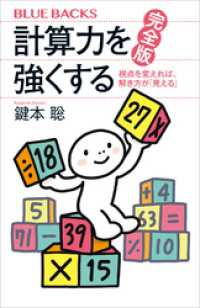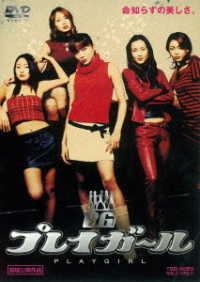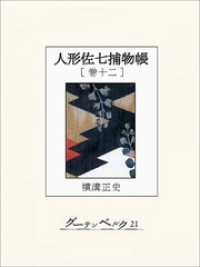- ホーム
- > 洋書
Full Description
What kinds of curriculum materials do mathematics teachers select and use, and how? This question is complex, in a period of deep evolutions of teaching resources, with the proficiency of online resources in particular. How do teachers learn from these materials, and in which ways do they 'tailor' them for their use and pupil learning? Teachers collect resources, select, transform, share, implement, and revise them. Drawing from the French term « ingénierie documentaire »,we call these processes « documentation ». The literal English translation is « to work with documents », but the meaning it carries is richer. Documentation refers to the complex and interactive ways that teachers work with resources; in-class and out-of-class, individually, but also collectively.
Contents
Foreword: R. Sträßer, Professor of Mathematics Education, Giessen, Germany.- Introduction: G. Gueudet, B. Pepin & L. Trouche.- Section 1: Teacher resources.- Chap. 1 (J. Adler): Knowledge resources in and for school mathematics teaching.- Chap. 2 (G. Gueudet & L. Trouche): Teachers' work with resources: documentational geneses and professional geneses.- Chap. 3 (G. Sensevy): Patterns of didactic intentions, thought collective and documentation work.- Chap. 4 (M. A. Mariotti & M. Maracci): Resources for the teacher from a semiotic mediation perspective.- Reaction to section 1: B. Barton, President of ICMI, University of Auckland, New Zealand.- Section 2: Text and Curriculum resources.- Chap. 5 (K. Ruthven): Constituting Digital Tools and Materials as Classroom Resources.- Chap. 6 (J. Remillard): Modes of Engagement: Understanding Teachers' Transactions with Mathematics Curriculum Resources.- Chap. 7 (B. Pepin): Task analysis as 'Catalytic Tool' for feedback and teacher learning: Working with teachers on mathematics curriculum materials.- Chap. 8 (W. Schmidt): The Cumulative Effects of Middle School Tracking: How Content Coverage Varies.- Chap. 9 (C. Proust): Teachers' writings and students' writings': school material in Mesopotamia.- Reaction to section 2: M. Swan, Professor of Mathematics Education, Shell Centre, The University of Nottingham, UK.- Section 3: Use of resources.- Chap. 10 (C. Kieran, D. Tanguay & A. Solares): Researcher-designed resources and their adaptation within classroom teaching practice.- Chap. 11 (D. Forest & A Mercier): Classroom's video data and teaching resources: Some thoughts on teacher education.-Chap. 12 (S. Rezat): Interactions of teachers' and students' use of mathematics textbooks: A study of documentational genesis.- Chap. 13 (M. Trigueros & D. Lozano): Teachers teaching mathematics with Enciclomedia.- Chap. 14 (P. Drijvers): Teachers transforming resources into orchestrations.- Reaction to section 3: L. Radford, Professor of Mathematics Education, Laurentian University in Ontario, Canada.- Section 4: Collaborative use.- Chap. 15 (C. Winsløw): A comparative perspective on teacher collaboration: the cases of lesson study in Japan and of multidisciplinary teaching in Denmark.- Chap. 16 (G. Gueudet & L. Trouche): Communities, documents and professional geneses: interrelated stories.- Chap. 17 (J. Visnovska, P. Cobb & C. Dean): Mathematics teachers as instructional designers: what does it take?.- Reaction to section 4: B. Jaworski, Chair in Mathematics Education, Loughborough University, UK.- Closing reaction: D. Lowenberg Ball, Professor in Education, Dean, School of Education, University of Michigan, USA.- Conclusion: the editors.
-

- 電子書籍
- 計算力を強くする 完全版 視点を変えれ…
-

- 電子書籍
- 乙女椿は笑わない 分冊版 36 マーガ…
-

- 電子書籍
- 俺たちマジ校デストロイ【分冊版】 8 …
-

- DVD
- プレイガール
-

- 電子書籍
- 人形佐七捕物帳 巻十二



